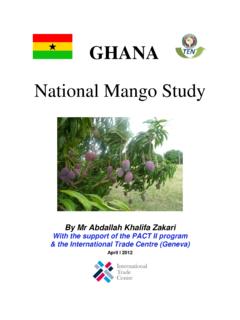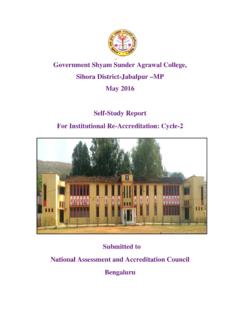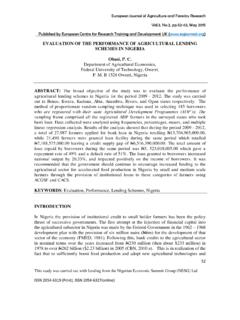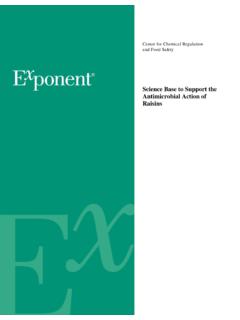Transcription of FOOD LOSS AND WASTE IN THE FOOD SUPPLY CHAIN
1 26 Feature ArticlesJuly 2017 | NUTFRUITFOOD LOSS AND WASTE IN THE food SUPPLY CHAINM aryam Rezaeiis a food technologist at FAO Nutrition and food Systems Division (ESN). Her work includes providing technical support to food loss and WASTE assessment projects and formulation of national strategies on value CHAIN development. She has an MSc. from Ecole Sup rieure d Agriculture d Angers in France. Bin Liu is an of!cer of Nutrition and food Systems Division, FAO. His work involves food processing technologies and assessing food loss and WASTE . Before joining FAO, he worked on value CHAIN development for International Potato Center in the estimated 30% of the food produced for human consumption globally is lost or wasted somewhere along the food SUPPLY chain1. Meanwhile, the world s population is predicted to reach billion by 2050 and this will require an increase of 70% in food A signi!
2 Cant part of this growth will take place in developing countries, where steadily increasing urban populations continue to create complex and lengthy food SUPPLY chains involving many actors, presenting challenges in delivering safe, nutritious food that is of good quality. Tackling food losses and WASTE in an ef!cient, sustainable and integrated way should be considered an opportunity to feed people and optimize the use of natural and !nancial resources at the same time. The private sector, including the food industry, can play an important and unique role in food loss and WASTE reduction by optimizing food processing procedures, streamlining SUPPLY chains and linking farmers to market, among other things. Reducing the loss and WASTE of nuts and fruits is especially signi!cant given their nutritional value and great potential for value is food loss and WASTE ?
3 food loss and WASTE is de!ned as a decrease in the quantity or quality of edible food that is intended for human consumption. The redirecting of edible food to be used as animal feed, converting food to bioenergy and dumping into land!lls are examples of a decrease in quantity. It is important to distinguish between food loss and food WASTE and the circumstances of their occurrence, especially when identifying causes and developing solutions and interventions to address this loss is mainly caused by the malfunctioning of the food production and SUPPLY system or its institutional and policy framework. This could be due to managerial and technical limitations, such as a lack of proper storage facilities, cold CHAIN , proper food handling practices, infrastructure, packaging, or ef!cient marketing WASTE refers to the removal from the food SUPPLY CHAIN of food which is still !
4 T for human consumption. This is done either by choice or after the food is spoiled or expired due to poor stock management or neglect. food WASTE typically but not exclusively happens at the retail and consumer levels whereas food loss takes place at the earlier stages of the food SUPPLY CHAIN during production, post-harvest and processing stages. Implications of food loss and WASTE food loss and WASTE have signi!cant negative food -security, economic and environmental impacts. The value of annual food loss and WASTE at the global level is estimated at US$ 1 food loss and WASTE may decrease food availability in the market, which may in turn increase food prices and reduce the capacity of low-income consumers to access food . Moreover, if the quality of food deteriorates so badly that the food has to be sold at a lower price or even discarded, the livelihood of farmers and producers is adversely loss and WASTE represent wastage of the water, land, energy and other natural resources used to produce food .
5 In fact, the resources used to produce food that is eventually lost or wasted account for approximately gigatonnes of greenhouse gas emissions (CO2 equivalent) annually, making food loss and WASTE the world s third largest emitter, after only China and the United States3. Given that climate change has become a major concern among INC members4, the nut and dried fruit industry could bene!t from climate change mitigation measures, and one effective way is by reducing food loss and WASTE in their does food loss and WASTE take place in the food VXSSO\ FKDLQ"The level of losses differ from one stage of the food SUPPLY CHAIN to another, depending on crop type, level of economic development, as well as social and cultural practices in a region. In the case of fruits and vegetables, according to an FAO study,5 losses at harvest and during sorting and grading dominate in industrialized regions, probably mostly due to discarding during grading to meet quality standards set by retailers.
6 In developing regions, while losses at harvest and during sorting and grading are also high, losses during processing (14% 21%) are much higher than those in developed regions (< 2%), as depicted in Figure 1. The distinct difference highlights the need to improve processing technologies for perishable products like fruits and vegetables in developing regions. The food industry can make a substantial contribution in this area by developing and disseminating low-cost and effective techniques such as and solutions to reduce food loss and wasteDeveloping ef!cient solutions to reduce food loss and WASTE lies in the recognition of interlinkages among different stages of the food SUPPLY CHAIN . In other words, the performance of each actor and cost of activities in upstream segments of the CHAIN could determine the quality of the product further down the food SUPPLY CHAIN .
7 In this integrated SUPPLY CHAIN approach, special attention should be paid to the impact of technical interventions on the social context Europe60%50%40%30%20%10%0%NorthAmerica andOceaniaNorth Africa,West andCentral AsiaSouth andSoutheastAsiaLatinAmericaIndustrializ edAsiaSub-SaharanAfricaConsumptionDistri butionProcessingPost-harvestAgricultureF igure 1. Percentage of the initial production lost or wasted at different stages of the FSC for fruits and vegetables in different regions. Agriculture indicates losses occurring during harvest operation and subsequent sorting and grading. Post-harvest indicates losses occurring during handling, transportation and storage immediately after harvest and before ArticlesJuly 2017 | NUTFRUITR eferences1. FAO. 2015. Global Initiative on food Loss and WASTE Reduction. Rome, FAO. (also available at ).
8 2. FAO. 2009. How to Feed the World in 2050. Background paper for High Level Expert Forum - How to Feed the World in 2050. Rome, FAO. (also available at !leadmin/templates/wsfs/docs/expert_ ). 3. FAO. 2013. food wastage footprint: Impacts on natural resources. Rome, FAO. 61 pp. (also available at ). 4. International Nut and Dried Fruit Council. 2015. World Nut and Dried Fruit Congress sets a new road map for the industry. In: PR Newswire [online]. [Cited 14 April 2017]. 5. FAO. 2011. Global food losses and food WASTE - Extent, causes and prevention. Rome, FAO. 29 pp. (also available at ). 6. Bloom, J. 2016. Kenyan farmers !ght food loss by drying, selling mangoes. In: National Geographic | The Plate [online]. [Cited 14 April 2017]. !ght- food -loss-by-drying-selling-mangoes /. 7. Anonymous. undated. SAVE food SUCCESSES: the Mango Project. In: SAVE food [online].
9 [Cited 14 April 2017]. 8. Anonymous. 2016. : Freeze-dried fruit and the !ght against food WASTE . In: [online]. [Cited 14 April 2017]. !ght-against- food - WASTE /. 9. Anonymous. 2017. Italian nut supplier cuts WASTE with new machine. In: [online]. [Cited 14 April 2017]. 10. Dr. Karli Verghese et al. 2013, Final report; role of packaging in minimising food WASTE in the SUPPLY CHAIN of the future, Australia. (also available at !le:///C:/Users/rezaei/Downloads/RMIT%20 study_The%20role%20of%20packaging%20in%2 0minimising%20food%20waste%20in%20the%20 SUPPLY %20chain_June% ).Copyright: food and Agriculture Organization of the United Nations (FAO). The views expressed in this publication are those of the authors, and do not necessarily re"ect the views or policies of the food and Agriculture Organization of the United environment and the cost of the solutions proposed should not exceed the cost of food that is lost.
10 For instance, improving on-farm storage facilities to reduce post-harvest losses should be coupled with proper strategies and interventions to enhance access to markets. In low-income countries, solutions should !rst and foremost take a producer s perspective, by improving harvest techniques, farmer education, storage facilities and cooling chains. In industrialized countries on the other hand, solutions at the producer and industrial levels would only be marginal1 if consumer education and appropriate stock management at retail level is not in place. Moreover, government investment on capacity building for agriculture and infrastructure and policy support to facilitate market access for farmers and to provide an enabling environment for private sector investment is a non-negotiable factor that cuts across most measures to reduce food loss and WASTE .















